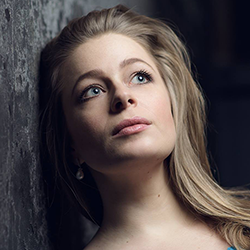
Siobhan Stagg & Timothy Young
This month, Siobhan Stagg and Timothy Young take to the Elisabeth Murdoch Hall stage to perform as part of Melbourne Recital Centre's International Classics series. Explore the program in this excerpt from the official program notes, written by Phillip Sametz.
About the music
The term ‘small but exquisite’ accurately describes composer Henri Duparc’s output. He died aged 85, and created his final original work 50 years earlier. Actually, the term ‘work’ is unhelpfully vague; he left us a handful of short pieces, one symphonic poem and – his greatest claim to immortality – 16 surviving songs. And of those songs, Duparc only acknowledged 13; the remaining three were rediscovered after his death.
‘Surviving’ is the optimal word, for Duparc was one of music’s supreme perfectionists. After writing his final song in 1884, he retired from composition altogether due to a nervous condition, and turned to his other interests, which included the creation of watercolours, pastels and drawings. Then he began to lose his eyesight. A man consoled deeply by his faith, he wrote of his condition in 1916: ‘Have I not loved too well the beauty of shapes and colours, and does not God wish me to live from now on a more interior life concerned solely with him?’ As writer James Harding remarked: ‘The last 40 years of his life were sustained by religious resignation and hopeful trips to Lourdes.’
A pupil of César Franck, Duparc became, like many of his composer compatriots, an ardent Wagnerian. (This did not prevent him becoming, after the Franco-Prussian war, secretary of France’s Société Nationale de Musique). In some ways all his songs are meditations on the chromatic ardour and unappeasable yearning of Wagner’s Tristan and Isolde.
Goethe’s Romance de Mignon has been set to music by more than 50 composers (including Beethoven, Liszt and Tchaikovsky). Duparc’s setting is one of his early songs (1869) and one he suppressed, as it did not meet his lofty standards. The change in mood between the second and third stanzas is striking, as is Duparc’s overwhelming response to the bitterness of the words. As soprano Lotte Lehmann said: ‘Something akin to madness rages through this song.’
The search for Le manoir de Rosamonde (1879) suggests a haunted, unrequited yearning while, in Au pays où se fait la guerre (1869, the text by Gautier), the longing for an absent beloved pulses through vocal line and accompaniment; at times – in the setting of the couplet ‘Who detains him so long, my God? See, the sun is setting’, for example – the sense of vulnerability and suffering is overwhelming. If you’re familiar with Gounod’s opera Faust, the melodic contours of Au pays où se fait la guerre may remind you of Marguerite’s Chanson du Roi de Thulé; in fact scholars surmise that this song was intended an opera of Duparc’s own, Roussalka, on which he toiled for more than ten years before finally consigning it to the flames.
Jean Lahor – the poet of Chanson triste (1868) and Extase (originally 1874) – was the pseudonym of physician Henri Cazalis, who may now be best known for the poem which inspired Saint-Saëns’ Danse macabre. Although he created no new music in the last 50 years of his life, the intensity of Duparc’s meticulousness is signalled by his subsequent revision of a few of his few songs, including Chanson triste in 1902; this is the version you hear tonight. He then orchestrated the song ten years later.
When Baudelaire published his most famous volume of poetry, Les Fleurs du mal, in 1857, he wanted a composer of genius would set one of its verses, L’invitation au voyage, and offer it to his beloved. This Duparc did in 1870, when he dedicated his shimmering setting of the poem to his wife. For his final song, Duparc again turned to Baudelaire; La vie antérieure (1884) is a profoundly beautiful response to the poem’s evocation of voluptuous contentment. Indeed the song, in effect, moves to and away from the line ‘It is there I lived in sensuous repose.’
All the French music on this program might be called ‘Extrapolations of the ecstatic,’ for Messiaen’s song cycle explores states of ecstasy, personal and spiritual. He wrote Poèmes pour Mi in 1936, four years after his marriage to violinist and composer Claire Delbos. They had a warm, loving relationship and often performed together, with Messiaen on piano. His pet name for Claire was ‘Mi’ which, in French musical nomenclature, is E, the highest string on a violin. The couple built a small holiday house on the shores of the Lac de Laffrey near Grenoble, and the first work he composed there was this song cycle to his own texts. He created Poèmes pour Mi as a gift, a token of love and a celebration of his marriage to Claire.
Although you might think of voice and piano as an essentially intimate ensemble, this is music which addresses the cosmos, calling for a voice the composer described as a ‘grand soprano dramatique.’ And, like all of Messiaen’s music, Poèmes pour Mi is underpinned by his fervent religious faith.
He evokes the beauty of the Lac de Laffrey, as seen from the Messiaens’ home, in Action de graces and Paysage, and the house itself in Le maison. There is an intense sense of thanksgiving, of blessedness, in this music, before Book I ends in fury, with Épouvante expressing a visceral fear that the blissful contentment of the earlier songs may be an illusion. As Messiaen scholar Philip Weller remarked: ‘In Messiaen’s poetic world, this dark world of fear and apprehension is to be faced, fairly and squarely, before being put to flight by the gift of love – his beloved “Mi”, their shared love of God and Nature.’
Sure enough L’Epouse, which opens Book II, unites the worlds of earthly and spiritual love in a mood of profound simplicity. Messiaen then meditates on the blessed beauty of Mi’s voice in Ta voix, before Les deux guerriers which, in some ways, plays the same disruptive role as did Épouvante in Book I. Here Messiaen depicts the two lovers as ‘warriors protected with iron,’ whose spiritual strength is, together, far stronger than either’s would be alone. In their atmosphere of loving fulfillment, the final two songs collectively close the circle established by Action de graces. In Le collier the gently rocking piano figures aptly encircle the radiant vocal line. The imagery in the text – ‘Curved landscape, married to the fresh morning air’ – is at once playful and radiant. Finally, the themes of temporal and spiritual union are brought to a luminous, exultant close in Prière exaucée, perhaps the most overtly theatrical song of the entire cycle.
Throughout the Poèmes pour Mi the shining, bell-like keyboard writing is married to a vocal line of hugely expressive ambition; all the while Messiaen finds the finest shades of colour and nuance he can draw from his text. Within a few years his imagination and daring would become even bolder in such works as the Quartet for the End of Time (1941) and the Turangalîa-Symphonie (1949).
This Be Her Verse was commissioned by soprano Golda Schultz and pianist Timothy Ware, for an album by these artists of songs by women, released on the Alpha Classics label in April 2022. Its librettist Lila Palmer explains: ‘When Golda first approached me to ask for a song cycle which centred female experience, I felt overwhelmed by the sheer volume of experience absent from the song repertoire. How could I possibly hope to correct women’s erasure from the song tradition in programming and historiography with what could only be a drop in the bucket? And so I began with the personal: stories told by Golda and [composer] Kathleen Tagg about their experiences and those of the women they knew, and mined my own notebooks for observations and memories gauche, raw and reflective, stretching back from my early twenties to the present.’ And in Tagg’s words: ‘The idea was…to tell our stories – not those of “women’s stories” as told from the outside with the woman victimized or placed on a pedestal – but our stories in our own voices.’
Palmer’s text, which ranges from rage to despair, finds an acutely sensitive response in Tagg’s musical language, which runs effortlessly from cool to hot. Where Messiaen often uses melisma to indicate heightened joy or a sense of the sublime, for Tagg, in the second song, Wedding, it is a vehicle for a kind of furious irony. This Be Her Verse ends in a proud apotheosis, with the singer occupying an emotional space no composer of romantic art song, male or female, could have imagined.
©Phillip Sametz 2023

Siobhan Stagg
Australian soprano Siobhan Stagg was a member of the Deutsche Oper Berlin from 2013-19 where her roles included Pamina in Die Zauberflöte, Sophie in Der Rosenkavalier, Tytania in A Midsummer Nights’ Dream, Gilda in Rigoletto, Micaëla in Carmen, Adele in Die Fledermaus, Zerlina in Don Giovanni, Musetta in La bohème, Contessa di Folleville in Il viaggio a Reims, Marguerite de Valois in Les Huguenots and Waldvogel and Woglinde in The Ring Cycle conducted by Sir Simon Rattle.
Elsewhere she has sung the title role in Cendrillon for the Lyric Opera of Chicago; Pamina for the Royal Opera House Covent Garden; Sophie Der Rosenkavalier for the Opernhaus Zurich; Mélisande for Opera de Dijon and Australia's Victorian Opera (for which she received the Green Room Award for Best Female Lead in an Opera); Gilda, Blonde and Cordelia in Aribert Reimann’s Lear for the Hamburgische Staatsoper; Najade Ariadne auf Naxos for the Bayerische Staatsoper; Blonde for the Dutch National Opera; staged performances of Mozart’s Requiem at the Festival d’Aix-enProvence and Morgana Alcina and Marzelline Fidelio for the Grand Théâtre de Genève.

Timothy Young
Timothy Young is a much sought after recitalist, soloist and chamber musician performing regularly in Australia’s major festivals. His versatility and large repertoire has seen him forge a career as a pianist that highlights the eclectic nature of the instrument itself. As a concerto soloist he has performed with the Australian World Orchestra, the Melbourne Symphony Orchestra, the Melbourne Chamber Orchestra and play/directing the Australian National Academy of Music orchestra. As a regular recitalist with prominent instrumentalists and singers his experience and repertoire is extensive. A founding member of Ensemble Liaison, he has composed and made countless arrangements for their ‘Ensemble Liaison and Friends’ annual series. He has made numerous recordings for Decca, ABC Classics, Tall Poppies, MOVE records and Melba Records. Timothy is also a passionate educator and is Head of Piano at ANAM where he has been resident faculty for over 20 years, teaching and training Australia’s most talented young musicians.
Siobhan Stagg and Timothy Young traverse the beautiful terrain of French art song in Elisabeth Murdoch Hall on Monday 20 February.
Click here to book your tickets now.
You might also be interested in
-
-
-
Explore the program notes in advance

